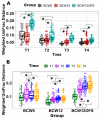Exercise and Prebiotic Fiber Provide Gut Microbiota-Driven Benefit in a Survivor to Germ-Free Mouse Translational Model of Breast Cancer
- PMID: 35681702
- PMCID: PMC9179252
- DOI: 10.3390/cancers14112722
Exercise and Prebiotic Fiber Provide Gut Microbiota-Driven Benefit in a Survivor to Germ-Free Mouse Translational Model of Breast Cancer
Abstract
The gut microbiota plays a role in shaping overall host health and response to several cancer treatments. Factors, such as diet, exercise, and chemotherapy, can alter the gut microbiota. In the present study, the Alberta Cancer Exercise (ACE) program was investigated as a strategy to favorably modify the gut microbiota of breast cancer survivors who had received chemotherapy. Subsequently, the ability of post-exercise gut microbiota, alone or with prebiotic fiber supplementation, to influence breast cancer outcomes was interrogated using fecal microbiota transplant (FMT) in germ-free mice. While cancer survivors experienced little gut microbial change following ACE, in the mice, tumor volume trended consistently lower over time in mice colonized with post-exercise compared to pre-exercise microbiota with significant differences on days 16 and 22. Beta diversity analysis revealed that EO771 breast tumor cell injection and Paclitaxel chemotherapy altered the gut microbial communities in mice. Enrichment of potentially protective microbes was found in post-exercise microbiota groups. Tumors of mice colonized with post-exercise microbiota exhibited more favorable cytokine profiles, including decreased vascular endothelial growth factor (VEGF) levels. Beneficial microbial and molecular outcomes were augmented with prebiotic supplementation. Exercise and prebiotic fiber demonstrated adjuvant action, potentially via an enhanced anti-tumor immune response modulated by advantageous gut microbial shifts.
Keywords: breast cancer; chemotherapy; exercise; fecal microbiota transplant; gut microbiota; prebiotics.
Conflict of interest statement
The authors declare no conflict of interest. The funders had no role in the design of the study; in the collection, analyses, or interpretation of data; in the writing of the manuscript, or in the decision to publish the results.
Figures











Similar articles
-
Exercise training-induced modification of the gut microbiota persists after microbiota colonization and attenuates the response to chemically-induced colitis in gnotobiotic mice.Gut Microbes. 2018 Mar 4;9(2):115-130. doi: 10.1080/19490976.2017.1372077. Epub 2017 Sep 22. Gut Microbes. 2018. PMID: 28862530 Free PMC article.
-
Wood-Derived Dietary Fibers Promote Beneficial Human Gut Microbiota.mSphere. 2019 Jan 23;4(1):e00554-18. doi: 10.1128/mSphere.00554-18. mSphere. 2019. PMID: 30674645 Free PMC article.
-
Spatial heterogeneity of bacterial colonization across different gut segments following inter-species microbiota transplantation.Microbiome. 2020 Nov 18;8(1):161. doi: 10.1186/s40168-020-00917-7. Microbiome. 2020. PMID: 33208178 Free PMC article.
-
Prebiotic effects: metabolic and health benefits.Br J Nutr. 2010 Aug;104 Suppl 2:S1-63. doi: 10.1017/S0007114510003363. Br J Nutr. 2010. PMID: 20920376 Review.
-
Gut microbiota and obesity: Impact of antibiotics and prebiotics and potential for musculoskeletal health.J Sport Health Sci. 2020 Mar;9(2):110-118. doi: 10.1016/j.jshs.2019.04.004. Epub 2019 May 3. J Sport Health Sci. 2020. PMID: 32099719 Free PMC article. Review.
Cited by
-
Examining the Mechanisms behind Exercise's Multifaceted Impacts on Body Composition, Cognition, and the Gut Microbiome in Cancer Survivors: Exploring the Links to Oxidative Stress and Inflammation.Antioxidants (Basel). 2023 Jul 14;12(7):1423. doi: 10.3390/antiox12071423. Antioxidants (Basel). 2023. PMID: 37507961 Free PMC article. Review.
-
From-Toilet-to-Freezer: A Review on Requirements for an Automatic Protocol to Collect and Store Human Fecal Samples for Research Purposes.Biomedicines. 2023 Sep 28;11(10):2658. doi: 10.3390/biomedicines11102658. Biomedicines. 2023. PMID: 37893032 Free PMC article. Review.
-
Intestinal Microbiota Influence Doxorubicin Responsiveness in Triple-Negative Breast Cancer.Cancers (Basel). 2022 Oct 4;14(19):4849. doi: 10.3390/cancers14194849. Cancers (Basel). 2022. PMID: 36230772 Free PMC article.
-
Prebiotics: Ignored player in the fight against cancer.Cancer Rep (Hoboken). 2023 Nov;6(11):e1870. doi: 10.1002/cnr2.1870. Epub 2023 Jul 17. Cancer Rep (Hoboken). 2023. PMID: 37458148 Free PMC article. Review.
-
The gut microbiota in breast cancer development and treatment: The good, the bad, and the useful!Gut Microbes. 2023 Jan-Dec;15(1):2221452. doi: 10.1080/19490976.2023.2221452. Gut Microbes. 2023. PMID: 37305949 Free PMC article. Review.
References
-
- Scott A.J., Alexander J.L., Merrifield C.A., Cunningham D., Jobin C., Brown R., Alverdy J., Keefe S.J.O., Gaskins H.R., Teare J., et al. International Cancer Microbiome Consortium consensus statement on the role of the human microbiome in carcinogenesis. Gut. 2019;68:1624–1632. doi: 10.1136/gutjnl-2019-318556. - DOI - PMC - PubMed
Grants and funding
LinkOut - more resources
Full Text Sources
Miscellaneous

